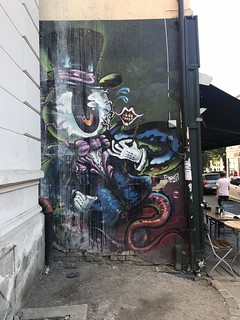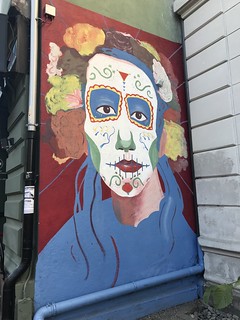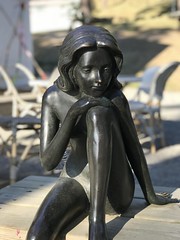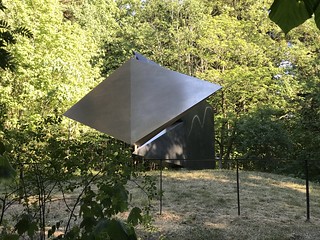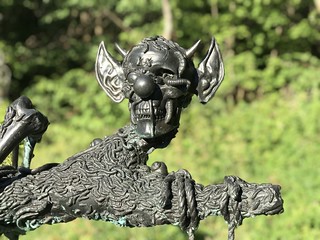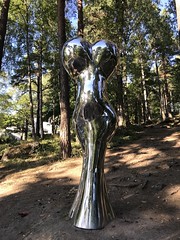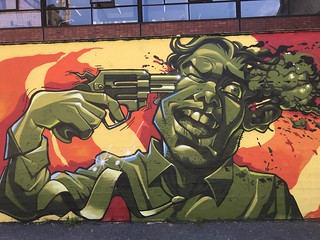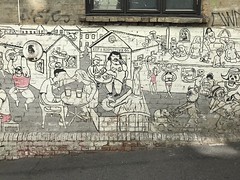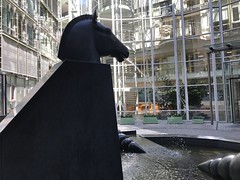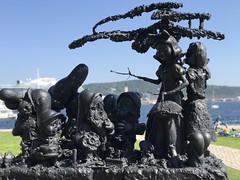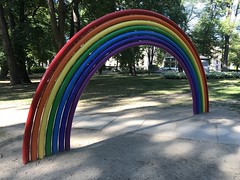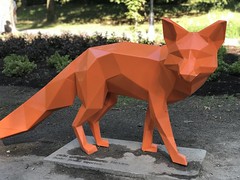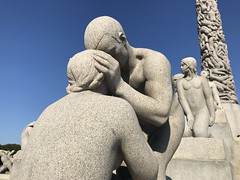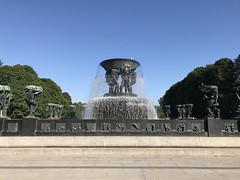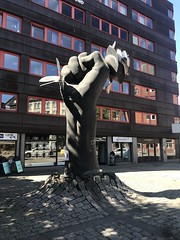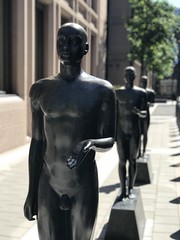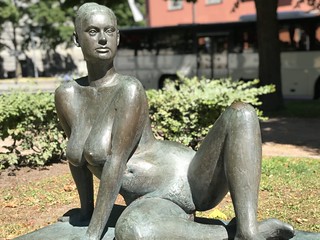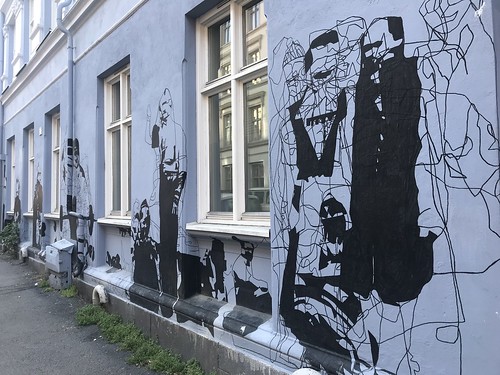
On my first night in Oslo I wandered the streets of Grünerløkka looking for a relaxing place to eat, then to find some groceries. Along the way I kept stopping to snap photos of the street art painted on the sides of buildings. These weren’t always off in the alleys but often on streets with pedestrians and streetcars passing by.
Thinking about it in retrospect I didn’t see much street art while visiting Hydra and Stockholm. Street art doesn’t go with the crumbling brick and stucco wall aesthetic of Greek islands, but what’s going on with Stockholm? I know there are places where to find street art but you have to head pretty far outside the main city to find it. Unfortunately I didn’t have enough time for such excursions.
Athens street art is its own story, which I wrote about during my visit last year. Go read that if you’re interested.

While heading back to the apartment with a bag of groceries I happened to walk through a small park. In that park I spotted a sculpture of a young woman clutching her belly. This got me thinking — why do we tend to think of outdoor murals as “street art,” but not outdoor sculptures? Art museums often feature both paintings and sculptures, so if street art is simply outdoor art without an admission fee, shouldn’t this description include sculptures as well as paintings?
I don’t mean to make this out to be a profound idea, but I kept coming back to it as I visited (or stumbled upon) Oslo’s outdoor art.
World War II memorials
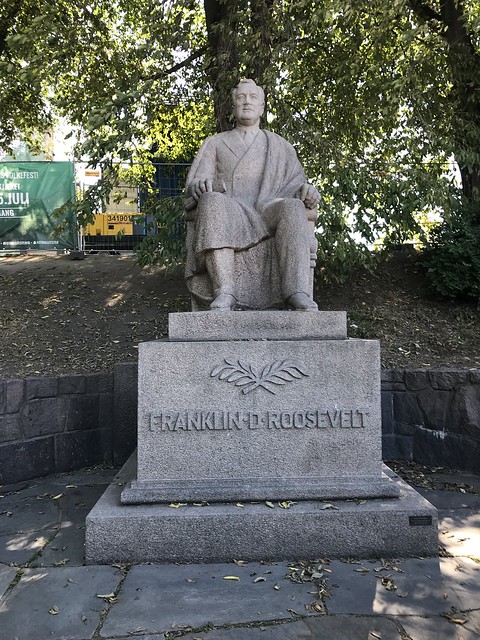
On a hill overlooking Oslo’s waterfront and a stone’s throw from city hall is a statue of American president FDR. Why? According to a tour guide Norway was criticized during World War II for falling to Nazi occupation despite initial Allied military support. This criticism felt unwarranted by Norwegians who fought the occupation, so when FDR took to the airwaves to commend the Norwegian resistance movement he earned the respect of Norway.
It’s worth noting the statue depicts FDR as the disabled man he was, sitting in a chair rather than standing, but doesn’t directly comment on this particular pose.
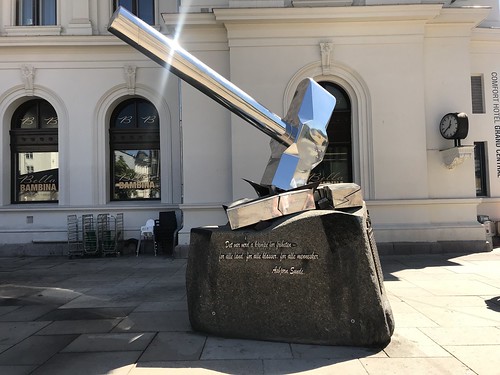
On the topic of WWII there’s a sculpture near Oslo S featuring a hammer smashing something on a stone slab. What’s the hammer smashing? It seems the artist made it intentionally difficult to view, let alone photograph.
The simple answer is the hammer is destroying a swastika. The more complicated answer; as you approach the shiny metal swastika, you’ll see your own face reflected in the mirror-like surface. What is this piece saying? Hopefully it’s quite obvious.
Sorry if that got depressing; let’s move on to some lighter works.
Ekeberg Park
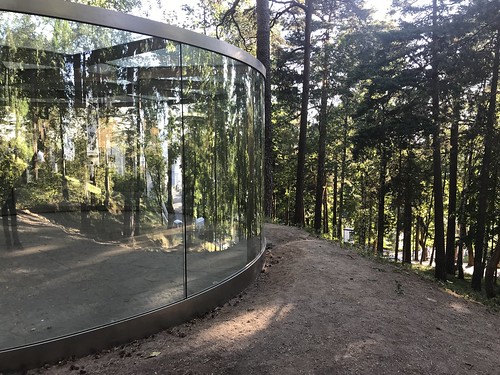
I took a streetcar to Ekeberg Park, a wooded hillside park that doesn’t seem to have caught on (yet?) with the tourist crowd much. Most of the people I saw in the park were clearly locals jogging or walking their dogs. There’s also a restaurant near the entrance which seemed pretty busy, and a lookout with a nice view of the city.
The park is best known as the place that inspired The Scream. One evening in the late nineteenth century Edvard Munch was taking a stroll through the park with some friends, and the sunset turned the sky a particularly vivid red hue. Munch interpreted what he felt was a scream from nature through the paintings (there are more than one.)
Over the past few years the park added various sculptures from different artists, ranging from more conceptual pieces to classic figures of humans. Some sculptures didn’t look like much during my visit, but outdoor sculptures can take on a very different context depending on the lighting or weather.
Blå
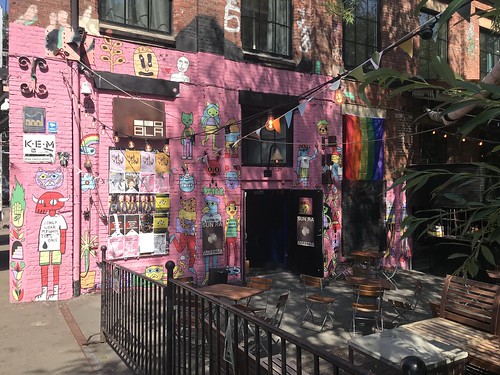
If you follow the river south from the Mathallen food hall there’s a bar and nightclub called Blå. You know you’re in the right place when you see walls covered in murals and various outdoor sculptures, including a giant chandelier dangling over an alley. During the day it’s a relatively quiet bar with a patio under the trees, at night it transitions into a music venue with everything from DJs to live music including jazz and hip hop.
The murals vary a lot in both style and quality, which makes sense when you consider there’s an art school campus a couple blocks away.
The Waterfront

Back in the day Oslo’s waterfront was an industrial neighborhood. But as in so many other blue collar parts of town around the world, the waterfront became luxury housing, upscale restaurants, tourist friendly museums, and picnic areas. The area around the Astrup Fearnley Museum is littered with sculptures to check out while enjoying coffee and ice cream from nearby vendors.
Royal Palace

I don’t know if this is a regular thing, but the Royal Palace gardens had a small temporary outdoor exhibition of sculptures. These were more pop-art crowd pleasers than typical outdoor art in Oslo — not that there’s anything wrong with that. Still, it took some waiting to get clear shots of these as people waited around for their turn to snap photos.
Individuals and groups of all ages wanted photos of themselves under the rainbow, or selfies with the faceless puppeteer. Much like the Color Factory or Museum of Ice Cream, perhaps this type of photo-friendly sculpture represents some hitherto unnamed future of participatory art. Who’s to say?
Frogner Park

Though the name is a little confusing, the infamous Frogner Park is the same thing as Vigeland Sculpture Park. The park is covered in sculptures by artist Gustav Vigeland as well as grass, gardens, and water features.
The sculptures are largely nude human forms in both metal and concrete. Some of them seem more serious than others, with the guy fighting off babies as the best known statue of the park’s more comical artistic stance.
During my visit I saw groups of tourists eagerly take their shoes and socks off to wade around in the water and take photos of one another. Scandinavians typically take their shoes off when entering a home, so I’d imagine this is pretty disgusting to the locals.
The park is a promenade extending from the entrance over to the phallic sculpture of human bodies tangled together at the other end. Several sculptures are hidden down non-obvious passages, such as the baby balanced on its head which is located in a dead-end under a bridge.
And then there was this mysterious sculpture. While it wasn’t originally intended to be a sculpture the phone company added a plaque to commemorate it as though it were one. After taking photos of the old phone booth a group of teen girls appeared behind me, waiting for their turn.
As I walked away I noticed one of them picked up the receiver and tried to make a call while the others used their smartphones to take pictures.
Everything else

What amazed me about Oslo’s outdoor art was how it’s everywhere — from big sculpture parks to small alleys, there’s something for everyone to find whether you set out to do so or are simply wandering from point A to point B. From the big colorful murals to the surprisingly clean statues (where’s all the bird poop?!) the outdoor urban landscape of Oslo is almost like an open air museum.
Aside from Frogner Park or what you may see on a guided tour, the majority of the outdoor art isn’t mentioned anywhere on the internet. I’m not sure it needs to be; part of the fun is spotting it on your own while spending time in Oslo.

